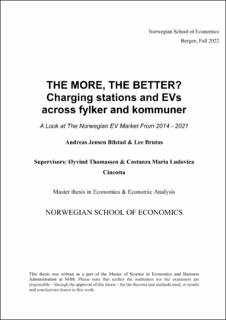| dc.description.abstract | In this master thesis, we have shown that building more chargers in a given year in a fylke or
kommune does not result in a significant increase in the amount ofEVs bought in this year in
this fylke or kommune after accounting for factors such as fast charging, accessibility, location
of the chargers, size of the population and income. This result holds for both fylker and
kommuner, even more so after accounting for heteroscedasticity and autocorrelation.
We have also considered the impact that chargers built in the past, for example one year earlier,
may have on the adoption of EVs in the year after. Taking this into account generates an
explanatory variable that is statistically significant which indicates that past charging stations
may be a better predictor of EVs bought in the future than chargers being made currently
available. This has also helped to deal with reverse causality.
This may to some extent help to alleviate the chicken and egg problem for policy makers
wondering what comes first: The cars or the chargers. This result holds at both the kommune
and fylke levels. However, after accounting for heteroscedasticity and autocorrelation, it only
remains significant at the fylke level. This suggests that the fylke may be a better territorial
unit to organize the charging network around in Norway than the kommune which makes sense
given that the kommuner in Norway tend to be only sparsely populated in comparison to the
fylker. | en_US |
